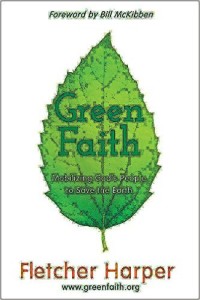GreenFaith: Mobilizing God’s People to Save the Earth
Reviewed by Rob Pierson
February 1, 2016
 By Fletcher Harper. Abingdon Press, 2015. 178 pages. $19.99/paperback or eBook.
By Fletcher Harper. Abingdon Press, 2015. 178 pages. $19.99/paperback or eBook.
Buy on FJ Amazon Store
In the glut of supposedly “eco-friendly” products, it’s tempting to shrug off yet another book with “green” in its title. But like Pope Francis’s recent messages on climate change, Fletcher Harper’s GreenFaith offers timely encouragement at a spiritual turning point. This book equips us for ministry, in this case a ministry of salvation involving the Earth itself. “Faiths uniting to save the Earth?” asks Harper, “Yes. The Earth helping save and revitalize faiths? Yes also, in equal part.”
Harper, an Episcopal priest, is executive director of an environmental interfaith partnership called GreenFaith. He aims his GreenFaith book at a similar ecumenical Christian audience. It may seem strange to characterize his call to environmental activism as “equipping for ministry,” but Quakers and others still employ this archaic phrase to describe the process of preparing Friends mentally and spiritually for public witness. Harper’s book equips in just this sense.
GreenFaith opens with a basic premise: “Nature, the outdoors, the environment, is fundamental to religious faith and spirituality.” The Earth isn’t a backdrop or a stage. It is the place where we experience “raw awe,” fear, humility, beauty, love, deep relationship, and an ethical awakening. Our connection to the Earth connects us to each other, to all life, and to the Divine.
For Harper, our sacred texts reflect and encourage this experience. He devotes two chapters to the Bible and one to themes from other religious traditions. In his view, the major religions share concerns including an ecologically grounded spirituality, stewardship, and justice. For example, Harper repeatedly cites the Koran’s provision for using earth itself—either water or dirt—for the ritual cleansing of our face and hands prior to prayer.
Biblically based environmentalists may find his insights powerful. When was the last time someone pointed out that the ubiquitously quoted John 3:16 (“God so loved the world . . .”) really does mean the world, and that a careful reading of apocalyptic verses in Matthew’s Gospel suggests that being “left behind” (i.e., here on Earth) expressed good news and the hope of the early church? Harper convincingly provides a green reading of both Old and New Testaments. The message is the Earth is good, and the fate of the Earth is not separate from our fate.
Halfway through, Harper shares the facts of the current environmental crisis—all the way down to carbon budget numbers—but he urges us to “hold fast to amazement and hope.” Neither despair nor sermonizing will generate action. (In fact, GreenFaith online has links to crucial research on what messages do move us to action.) What we need, Harper argues, is a new environmental narrative that affirms basic religious truths: that the Earth and life are good, that we depend on and inevitably impact nature in the course of living, and that nature possesses intrinsic value in and of itself.
We must also overcome the deadening absence of nature in many people’s lives and how “unnatural” it feels to talk about nature in a religious context. The book offers guidance for recovering a felt environmental connection, like worshiping outdoors, integrating nature into our churches and meetinghouses, sharing our experience through “eco-spiritual autobiographies,” or encouraging congregational field trips to green sites (Harper cites Friends Center, for those near Philadelphia, Pa.) and into polluted areas, where we often also encounter oppressed communities.
GreenFaith shares practices of religious communities already acting out this vision. For Friends, the book’s emphasis on justice, political engagement, and civic activism will be particularly welcome. Its call to action cites recent action by others, including protest and legal actions, and points to helpful resources, particularly at greenfaith.org.
GreenFaith’s message encourages work across Friend’s traditional faith divisions and fits well with the Kabarak Call for Peace and Ecojustice issued at the sixth World Conference of Friends in 2012. In addition, the book is ready-made for book clubs, individual, and group study. Harper writes in a conversational style with questions at the end of each chapter to open discussion and encourage action: for example, “Do people in your faith community take environmental concerns seriously? Enough to actually do something about them?”
GreenFaith and greenfaith.org prepare us to answer this call and query. They equip us to walk cheerfully over the world answering that of God in all we meet, not only that of God in people but in the creation as a whole.



Comments on Friendsjournal.org may be used in the Forum of the print magazine and may be edited for length and clarity.